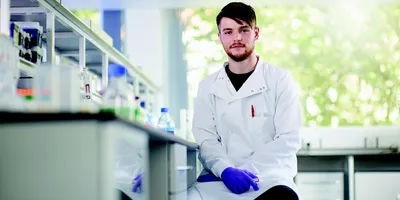
Tracking danger precisely and at miniscule levels
To keep ahead of and be able to manage security threats, governments require increasingly advanced methods for surveillance and testing. One of those is inductively coupled plasma mass spectrometry (ICP-MS).
With ICP-MS, an ICP ionizes the sample, which is then analyzed with MS. This technology can detect some elements at concentrations as low as parts per quadrillion. Moreover, this approach can be used in many applications of homeland security. Sayuri Otaki, ICP-MS marketing manager at Agilent Technologies (Tokyo, Japan), says that the key applications in homeland security involve toxic elements—metals and nonmetals—in air and water. Otaki says, “Examples would include toxic metal-based compounds, such as methyl mercury and inorganic arsenic in water.” She adds, “Other examples would include organophosphorus compounds, such as pesticides and nerve agents— chemical weapons—in air or water.” ICP-MS can also reveal the addition of toxic metals in foods.
The breadth of applications also makes this technology useful for a broad range of users. In particular, federal agencies around the world could use ICP-MS. In the United States these agencies include the Centers for Disease Control and Prevention (CDC), the Department of Defense, the Department of Homeland Security, and the Environmental Protection Agency. In addition, many state and local government agencies can use this technology.
Advances in analysis
When asked about recent advances in ICP-MS, Otaki says that a key one is “higher sensitivity to enable ultra-trace detection of toxic elements with minimum sample preparation or preconcentration.” While single-quadrupole MS has been improving basic performance, triplequadrupole MS provides far higher sensitivity by using the unique MS/MS reaction cell technology. It also allows detection of difficult-to-detect elements—such as arsenic, phosphorus, and sulfur—at a level that single-quadrupole MS cannot achieve. For instance, Otaki says that using triple-quadrupole MS enables the detection of arsenic “in the presence of common environmental matrices, including chlorides.”
If researchers add gas chromatography and then use ICP-MS with triple-quadrupole MS, even more can be detected. Here, says Otaki, this analysis can provide exquisite detection levels of organophosphorus and organo-sulfur chemical warfare agents in food, soil, water, and air samples.
Improving the detection—as with many forms of analysis—depends on reducing interference from unwanted material. With ICP-MS, a collision cell removes interfering ions. Iouri Kalinitchenko, R&D manager for ICP-MS at Analytik Jena, points out that traditional collision cells are placed after the deflecting ion optics, and his company’s patented integrated Collision Reaction Cell (iCRC) comes in front of those optics. He says this cell “uses ion kinetic energy discrimination to move away unwanted polyatomic interferences from entering the mass analyzer.” He adds, “This helps in obtaining the correct result every time in even the most challenging matrix samples.”
Arsenic as a weapon
All threats from terrorism do not need to be biological or even modern concoctions. For example, the CDC points out that arsenic can be used as a weapon. Exposure to this element can cause cancer and high doses can be deadly. The outcome depends on the degree of exposure and the type of arsenic, which comes in inorganic and organic forms. According to Kalinitchenko, organic arsenic is “about 500 times less harmful compared to” inorganic arsenic.
ICP-MS can discriminate between the types of arsenic. For instance, Kalinitchenko provided a readout from high performance liquid chromatography (HPLC) coupled with Analytik Jena ICP-MS applied to a solution that contained five forms of arsenic at concentrations of 1 microgram per liter. The resulting peaks clearly distinguished the various forms of arsenic, including inorganic and organic ones.
The arsenic can also be measured from various solutions. As an example, Kalinitchenko showed data from apple juice. Using HPLC-ICP-MS, the technology clearly revealed the kinds of arsenic, even at concentrations of a few parts per trillion. Such techniques could be used to test foods and compare typical levels of arsenic to establish a baseline for tainted or poisoned products.
Human exposure to arsenic could also be tested with ICPMS. For example, normal levels of arsenic in urine could be compared to samples from people suspected of exposure to unhealthy levels in instances of terrorism. For this application, Kalinitchenko showed results from analyzing urine with HPLC-ICP-MS. Specifically, these results came from using Bruker HPLC with the Analytik Jena PlasmaQuant MS ICPMS, and the results were compared to values from certified reference materials. Again, the various forms of inorganic and organic arsenic could be clearly observed in distinct peaks in the readout. This analytical setup provided detection of five forms of arsenic down to a few nanograms per liter.
Extensive opportunities
This article only explores a couple of the possible uses of ICP-MS in homeland security. It can also be used to test many other potential tools of terrorists. For example, ICP-MS can detect and identify fractions of a picogram of nuclear isotopes.
When it comes to terrorism, explosives must also be considered. Government and law-enforcement agencies need effective and sensitive techniques to detect explosives, and ICP-MS can be used.
In a 2015 issue of Forensic Science International, for example, a team of researchers from the Netherlands used ICP-MS to study ammonium nitrate, which is often found in forensic studies of explosives. The authors pointed out that ammonium nitrate is “widely available as fertilizer and easy to implement in explosive devices.” Just mixing it with fuel creates an explosive. This team wondered if ICP-MS could discriminate between different batches of ammonium nitrate, so they analyzed 103 samples from 19 fertilizer manufacturers. They concluded: “Samples with a similar elemental profile may be differentiated based on their isotopic composition.”
Protecting citizens requires tools with these wide-ranging capabilities. Also, this field demands effective ways to detect and analyze new threats. Lives around the world depend on it.
For additional resources on ICP-MS for homeland security, including useful articles and a list of manufacturers, visit http://www.labmanager.com/ms









